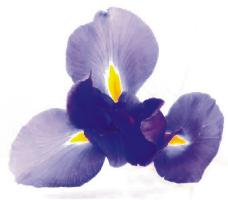
Some 300 species of iris are known, many of them native to Northern Europe and found in a vast range of habitats, from marshland, grassy slopes to arid and stony mountain tops in Europe, the Middle East and North Africa, Asia and through the northern U.S. The iris germanica is the largest group and they themselves are split into subgenera ranging from the minis at 15cm tall up to the tall at 1m.
Strictly, they are perennial herbs with sword-shaped, grey-green leaves developing in a fan from creeping rhizomes. The flowers bear six petals; three 'falls', often adorned with stripes, mottling and the typical 'beard' and three upright petals, or 'standards'. The markings on the 'fall' petals are thought to attract pollinating insects and, indeed, form a perfect landing pad!
Linnaeus penned the name iris for this genus of flowers with their immense range of hues, and a wise choice it was as the Goddess Iris was the personification of the rainbow – and surely nothing could be more apt. She was married to the God of the west wind, Zephyrus, and was the messenger between the Gods and Humans – the only road she ever travelled upon was the rainbow, which vanished when her task was completed. As spokeswoman for the Gods she was considered a conciliator and mediator, linking the Heavens to the Earth, restoring peace in Nature – as the beautiful iris flower brings pleasure and tranquility to our minds.
Some 300 species of iris are known, many of them native to Northern Europe and found in a vast range of habitats, from marshland, grassy slopes to arid and stony mountain tops in Europe, the Middle East and North Africa, Asia and through the northern U.S. The iris germanica is the largest group and they themselves are split into subgenera ranging from the minis at 15cm tall up to the tall at 1m.
Strictly, they are perennial herbs with sword-shaped, grey-green leaves developing in a fan from creeping rhizomes. The flowers bear six petals; three ‘falls’, often adorned with stripes, mottling and the typical ‘beard’ and three upright petals, or ‘standards’. The markings on the ‘fall’ petals are thought to attract pollinating insects and, indeed, form a perfect landing pad!
They are wonderful plants for our sunny climate and, with their ease of cultivation and propagation, they are, deservedly, popular. They love it bakingly hot and dry and should always be planted with the upper half of their rhizome exposed to the sun. Too much water or shady conditions can cause them to rot. Plants will soon clump up into big groupings which look stunning when in flower and are neat, tidy and carefree for the rest of the year – you’ll only need to periodically remove dead leaves. By growing different colours you can get a continuity of flowering stretching from early in the year through to about May. After flowering, the clumps can be lifted and split into sections for re-planting, thus easily increasing stocks and keeping the mother plant in strong growth and full of flower.
Modern-day breeding techniques have given us scented iris, repeat-flowering iris (usually around October), ruffled and picotees and a range of colours you need to see to believe. The only colour that has so far eluded the breeders is a true red – though some colours are very close.
The white iris, displayed on a red background was always the symbol of the powerful Medici family and became the flower of Florence. After a political reversal, it was decided to change the symbol to a red iris on white, and since then the hunt has been on to breed that true red. Catherine de Medici carried this symbol to Paris when she married the King of France and there it was remodelled as the stylish fleur-de-lis, thereafter much used in all sorts of decorative forms.The iris is the symbol of the City of Brussels since neighbouring Saint Gaugericus Island was carpeted with them; it is seen in the Quebec flag and it is the universal logo of the Scouts movement.
The thick, fleshy rhizomes are the source of orris root, used in perfume and traditionally as a medicine, a treatment for liver and spleen dysfunctions. In the perfumery trade the rhizomes are much valued for their ephemereal and changing aroma. Harvested, dried and aged for up to five years, the fresh roots smell earthy, acquiring their delightful violet odour slowly, intensifying with age. Aged rhizomes are steamed to produce a thick oily liquid known as iris butter. Aromatherapy oils, based on orris, are used for calming and sedating. Magellan Gin from Italy uses the iris roots as one of the secret ingredients to its distinctive flavour.
We have a good selection of colours available at the garden centre – try ‘Debrenee’, smokey lavender-pink standards with burgundy falls, ruffled and with a tawny beard, or ‘Marcel Turbat’, orange with a golden-red beard and repeat flowering – to name just a couple.
Lorraine Cavanagh has lived in Spain for 22 years; a mother, grandmother and hispanista, her passions are plants, the environment, food and drink, and travelling within Spain. She owns a small plant nursery near Cómpeta, is a landscape gardener and a writer. She also has a weekly spot on OCI radio. Her book Lorraine Cavanagh’s Mediterranean Garden Plants has been nicknamed ‘the bible’ and it is generally available throughout Spain, flexi-cover €24 and hardback €31.
See also “There are No Flies ….. only Foreigners!” a social history of Andalucia and light hearted look at life in Spain. E-mail: florenaspain@hotmail.com






















